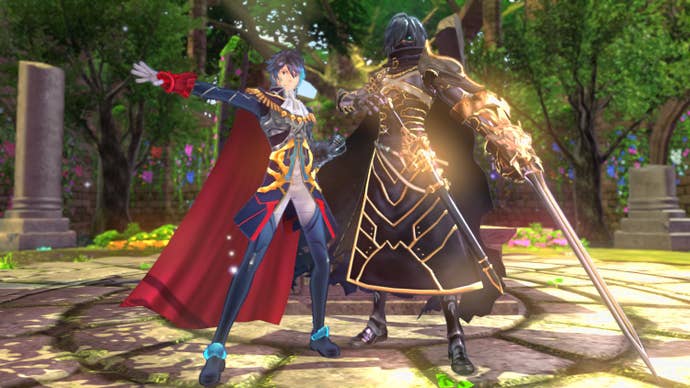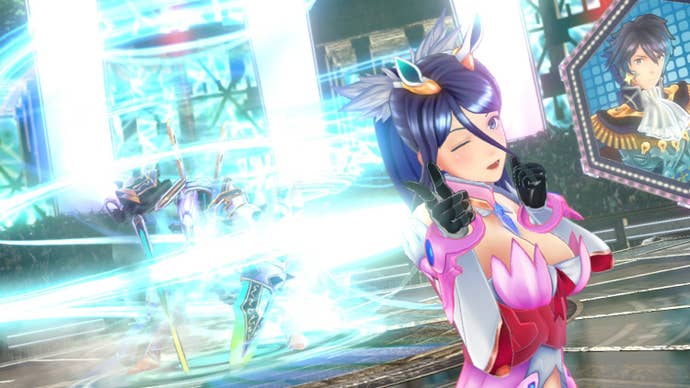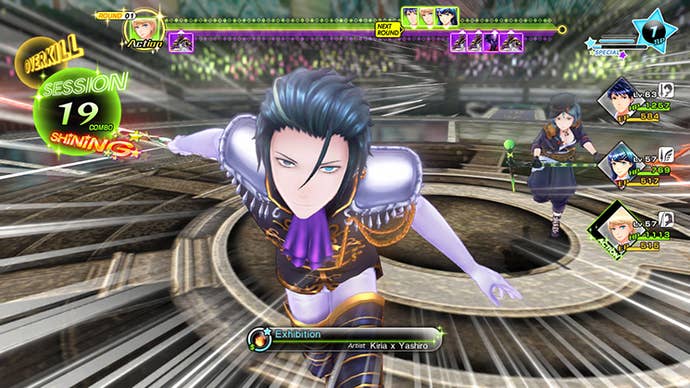Tokyo Mirage Sessions #FE Review: Music to My Ears [Update: Final Score]
Atlus gives the Wii U one great RPG as a swan song.
This article first appeared on USgamer, a partner publication of VG247. Some content, such as this article, has been migrated to VG247 for posterity after USgamer's closure - but it has not been edited or further vetted by the VG247 team.
I'm glad Tokyo Mirage Sessions #FE exists.
This game is an unlikely pairing, bringing Fire Emblem from Nintendo and Intelligent Systems together with Shin Megami Tensei from Atlus. Right from the first announcement, there were questions as to what form this crossover would take and I'm sure no one predicted this as the final product. The Japanese sales were less than stellar and the game itself is steeped in Japanese entertainment culture, so the fact that Nintendo and Atlus took a chance on the localization is surprising.

Bringing It All Together
Tokyo Mirage Sessions feels very much like a Persona game with Fire Emblem characters and concepts grafted on. Itsuki Aoi is out watching an idol contest when the entire group of contestants, including his childhood friend Tsubasa Oribe, are consumed and taken to another dimension. This dimension, the Idolasphere, is the realm of Mirages, wandering spirits that latch onto humans to draw out their Performa, an energy source borne of creative expression and performance. Itsuki uses his intense Performa to purify a Mirage, becoming a Mirage Master in the process.
This is the part that's reminiscent of a Persona title, with the purified Mirages bonding to a specific Mirage Master. This is also how Fire Emblem largely factors into the title: all of the Mirages, good and evil, are based on characters from the Fire Emblem series, primarily the first game and the popular Awakening. Fire Emblem: Awakening's Chrom is Itsuki's bonded Mirage, Caeda from the first Fire Emblem is joined with Tsubasa, Tiki from the first Fire Emblem and Awakening is the team crafter back at home base, and villains include Fire Emblem Awakening's Aversa and Gangrel and Fire Emblem's Abel, Palla, and Medeus. The heroes are easy to spot, the villains take a little bit more work as they've been Shin Megami-ed.
In addition, Tokyo Mirage Sessions features heavily themed dungeons, with antagonistic Mirages defining sections of the Idolasphere based on the careers and creative drives of their hosts. In Persona, it was based on the fears of the host, but the effect is similar here, leading to a host of colorful and unique dungeons for players to wander through, many with specific puzzles or methods of forward movement through the dungeon.

This is My Fight Song
Tokyo Mirage Sessions #FE features a straightforward turn-based battle system. Your party of three can attack, use skills, or items against the assorted enemies, and everyone's order of attack is shown on an action timeline, like Grandia. #FE leans hard on what it calls the Session system. Your characters use skills that exploit an opponent's weakness (based on Fire Emblem's Weapon Triangle and Shin Megami Tensei's Elements) and can activate Sessions, where the rest of the party will follow-up with another attack.
Sessions are key to simply progressing through Tokyo Mirage Sessions at a certain point. Outside on the first skill, Session attacks are free, costing no spots in the order of attack and consuming no EP. The game is tuned with the expectation that you're using this free damage all the time.
Each Mirage has different Carnages, Tokyo Mirage Sessions' version of weapons, that they can be transformed into if you have the requisite Performa crafting materials found on the corpses of enemies. (Be prepared to do some farming occasionally.) As you play through the game, using a Carnage will level it up and unlock skills in three main categories: Command, Session, and Passive. Command Skills are your physical or magical skills, attacking enemies, buffing your party, or debuffing foes. Session skills play off of Command skills when they exploit weaknesses and Passives are simply equipped, providing always-on effects.

The focus of team composition is skill synergy for Sessions. You want to pick a team of three that will counter the enemies in a dungeon; every Mirage Master has certain weapon and elemental affinities on their Command and Session skills (and themselves, depending on the Carnage being used). You also want to equip Session skills that work well with the rest of your party, so you can create long Session chains to deal maximum damage. That's all before you get to concepts like Overkill, Dual Performances, Ad-Libs, or Special Performances, which are ultra-powerful attacks that charge by using Sessions.
You will spend a good deal of time rejiggering your team composition, changing Carnages, and moving skills around to be an effective fighting force. Combat isn't hard, it just requires proper planning, especially when you run into the occasional "Savage" enemy in a dungeon. These foes are tuned much harder than the rest of the dungeon, just to mess with your Mirage murdering flow, and that's before you get to bosses.

Not Pop Idols, Pop Culture
A great deal has been made about the Japanese pop idol focus of Tokyo Mirage Sessions #FE, but in reality the focus is much broader than that. Yes, there are songs and yes, two of the characters are idols, but the rest expand outward. Itsuki doesn't really want to do anything outside of saving people and helping Tsubasa become an idol. Touma wants to be a tokusatsu stunt actor. Mamori is a television star and Eleonora wants to make it big in Hollywood. You'll run across composers, photographers, directors, and announcers, too.
The general theme of Tokyo Mirage Sessions is one of self-discovery and creative drive. Each of the characters wants a fulfilling career and even if they're at their height, like Kiria and Yashiro, there's likely something missing in their lives. Understanding that missing part is played as an awakening of greater facets of their Performa, additional Radiant Skills that provide some great benefits to your party. Even the antagonists are presented as the darker side of creativity, letting your drive to succeed outweigh your health or the well-being of others around you. It's a strong theme done very well.
The plot (so far) isn't the greatest or most original, but the cast is uniformly enjoyable, from the cute Tsubasa, to the boisterous Barry Goodman, and the cold Yashiro. It's not the Persona 4 cast, but I'd slot them in next to Persona 3's team.

Not only does the story see them grow, but you also have the chance to take on additional side-missions that show you new facets of their personalities, like stoic team leader Kiria's love of cute things. Itsuki is the only one who lets you down in this regard, probably because he's meant to largely be the player avatar. As I said, in my Tales of Zestiria review, a great cast is a large part of what makes a game click and the cast in Tokyo Mirage Sessions does its job admirably.
Tokyo Mirage Sessions #FE is a great JRPG that I have a feeling will wrap up in around 50-60 hours of playtime. It looks great, fans of anime and Japanese culture in general will get a kick out of the game's subtitle-only presentation, and the songs are pretty catchy. Combined with a great battle system, Tokyo Mirage Sessions #FE more than earns its place in your JRPG collection. And at the very least, it should keep you flush until Persona 5 comes out next February.
The only reason it's not getting a score is because I'm not done yet and the game could stumble across the finish line. Stranger things have happened.
Update: Having finished the game, I'm happy to say that it held onto its strengths all the way to the end. Tokyo Mirage Sessions #FE doesn't reinvent the wheel and it doesn't really add anything to the overall lexicon of Japanese RPGs. Despite that, the story is solid and straightforward, the characters are quite enjoyable, and the battle system's presentation is top-notch. Sure, the hooks to Fire Emblem and Shin Megami Tensei feel slight, but I honestly think that's a boon, as anyone can jump onboard with little issue. Atlus continues to do great work with Tokyo Mirage Sessions #FE and if you're a Wii U, it's an amazing coda for the system's JRPG catalog.
InterfaceThe Atlus polish means you gets a great-looking UI, even if the battle screen can get busy at times.
SoundThe songs are by Avex Trax and live up to their J-pop reputation.
VisualsOutside of Catherine, this is the first HD game from Atlus. It looks great and character designs by toi8 carry it forward.
ConclusionTokyo Mirage Sessions #FE has a little bit of Fire Emblem and Shin Megami Tensei for flavor, but honestly the title stands out as its own thing. Fans of Shin Megami Tensei spinoff Persona will find a lot to love: great characters, a heavy dose of Japanese entertainment, and a solid battle system. And if you're a Wii U owner, this is a great RPG to close out the system's lifespan.

